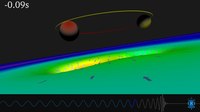
Photo from wikipedia
The ESA/JAXA (Japan Aerospace Exploration Agency) BepiColombo mission is currently in its cruise phase and is set to reach Mercury in late 2025. The spacecraft is equipped with advanced radio-tracking… Click to show full abstract
The ESA/JAXA (Japan Aerospace Exploration Agency) BepiColombo mission is currently in its cruise phase and is set to reach Mercury in late 2025. The spacecraft is equipped with advanced radio-tracking instrumentation that provides accurate radiometric data for precise orbit determination (POD). During the cruise phase, the radio link enables tests of general relativity (GR) and measurements of the solar corona properties. To fully exploit the accuracy of the radiometric measurements (Doppler and ranging) and to obtain better accuracies in the GR tests, a comprehensive dynamical model of the spacecraft is needed. A reliable and precise model of the non-gravitational accelerations would maximize the scientific return of the radio-science experiments and prevent unmodeled dynamic perturbations from degrading the POD solution. In this work, we investigate the effects of non-conservative forces acting on BepiColombo during three different radio-science campaigns conducted in November 2020, March 2021, and February 2022. The last two periods correspond to the first two GR tests of BepiColombo. We design a method for modeling these forces using telemetry measurements, radiometric observables, and mathematical models; and we analyze their characteristics in relation to the different environments encountered by the spacecraft during the three periods. This work is a preparatory and unavoidable step for the data analysis of the first two GR experiments of BepiColombo and the next radio-science campaigns, which will be performed in an even more challenging dynamical environment.
Journal Title: Journal of Spacecraft and Rockets
Year Published: 2023
Link to full text (if available)
Share on Social Media: Sign Up to like & get
recommendations!